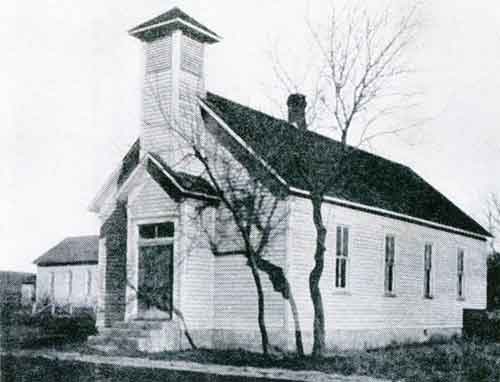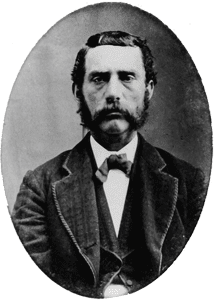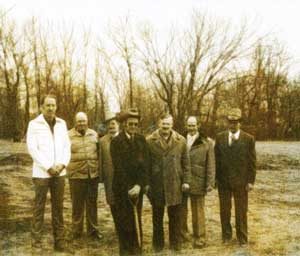
No period of history has created greater turmoil in America than that time referred to as the Civil War era. The great western movement of the day was brought on by the desire to find peace and freedom. An early document lists eleven families that came from Indiana to the upper Neosho valley in one wagon train, bringing fifty- six new citizens to the area that was already quickly filling up. Some of the names included in that group were Churchman, Burton, Atkinson and Ramsey.

Evidently no building in the area that was to later be the location of Parkerville was of a size sufficient for church meetings, so the Morris school house several miles down the Neosho River was chosen as a temporary meeting place. The organizer, Elder Ezra Johnson, had been born in Ohio, but was a resident of the Willow Springs Township of Douglas County at the time that the church was organized on October 26, 1865. Elder Johnson would gather several such little churches together in an organization called “The Union Baptist Association of Kansas.” This organization was probably mostly for fellowship and encouragement.
According to the surviving church clerk’s book, by September of 1867, services were being held in Parkerville in the Black School House. No doubt this school was named after the Thomas Black family. The exact location of this building is uncertain, but it is reported to have been a log building south of where the west end of the bridge, that is southwest of town, is now. At that time there was only a low-
water crossing there.
In May of 1878, a motion was made and adopted that “the church be moved from Parkerville to the school house in District 20 in Morris County”. Exactly why this decision was made is unknown, but this school, known as “The Burton School,” was located three miles west of the Parkerville Cemetery and one mile south. At this time a portion of the congregation made this move west, but a portion of it stayed in Parkerville, and according to the local newspaper, was quite active.
At a business meeting in February of 1880 the congregation in the country voted to build a church house at the grave yard south of M. H. Burton’s (two miles west of the Parkerville Cemetery and one mile south). It would be 26 by 40 feet. Few details remain pertaining to the building of the new church. One item remained, however. A photo of the student body of the school has survived with well over thirty students smiling out at the camera. In the same area comprised by the old school district, only one family with two small daughters now resides. Changes in our rural demographics have been dramatic in the passing years.
Meanwhile in Parkerville, that portion of the church was also busy preparing for the future. Announcements were made pertaining to the building of a church in Parkerville. The cornerstone was laid on July 7, 1899, and work began. The contract price was $763, and it went smoothly. The new building was dedicated on September 3, 1899
One final event took place on the night of November 20, 1913, that brought the two parts of the Neosho Valley Union Baptist Church back together. About 9:00 PM the wind began to blow with increasing velocity. Before the night was over, the little church in the Burton Cemetery was completely destroyed. Some things were salvageable, but not much. In addition, already sociological changes were taking place. Fewer people were living in the community. Automobiles had come on the scene. Rebuilding seemed like an impossible task. Finally, in 1920, the two parts of the Neosho Valley Union Baptist Church came back together as one church, and remain so today.
The church prospered with the addition of the congregation from the Burton Church and there was soon talk of building on. A choir addition, with a place for the pulpit, was planned. On February 3, 1927, a building committee was appointed and work began. Work progressed well and May 15 was the day identified for dedication of this addition. A large crowd gathered for the morning service and at the close of the service, $428.00 was raised to finish the work.
In spite of the nation-wide depression, the United Electric Company, now known as Westar, was building power lines into the valley. On February 5, 1931, it was voted to put “electric lights” into the building. Labor and material for the project totaled $26.00. The electric bill usually ran $1.00 per month in those years.
Anton “Tony” Peterson was one of those people that you could usually count on being in church. When the doors were open, 48-years old and unmarried, Tony would be there. In fact, he had just assisted in the raising of the money to install the electric lights in the church. It was discovered that Tony was missing by his brother-in-law, who lived in the same community. He lived alone, just beyond the railroad tracks, four miles north of the Parkerville Cemetery. His home showed no sign of trouble. He had been in church in Parkerville the night before. He went home from church that night in 1931 and was never seen again.

With every sign of a growing congregation, the need for a modern building became apparent. Consequently, plans were soon prepared for an addition that would include modern rest rooms, a kitchen area, a fellowship area and a nursery. A building committee, comprised of Ivan McCully, Robert M. Roberts Sr. and John Kaiser, was appointed. A ground breaking was held on May 4, 1975, and work began. The addition was dedicated on June 20, 1976, and has been a tremendous blessing ever since.
A church in Topeka had arranged for a church designer by the name of Chuck Anderson, from Colorado, to visit them in regards to a new building. Contact was made with him, and he stopped here on the way to Topeka on May 25, 1978. He looked our plan over, and later presented us with a floor plan, which was pleasing to us, but would have to wait a while.
Meanwhile, attendance was continuing to increase and additional space was needed for a nursery/Sunday School room and an office. Someone came up with the idea of building onto the east side of the previous addition. We broke ground for that on February 2, 1980, and that additional space has been most useful.
It became obvious that additional sanctuary space was needed. On February 8, 1981, a group of our men were presented to the congregation, as dedicated to the Lord, to be the building committee. Don Schmidt was identified as chairman, and assisting him was Bob Rankin, Delbert Stone, Lyle V an Lew, Bob Crable, Bob Pretzer and Robert M. Roberts Sr. Richard Claypool was added after Bob Rankin and Lyle Van Lew moved from the community. Work began immediately, with the building of the foundation. This, plus the building of the trusses, was the only labor that was hired out to others. Many men worked many hours and when it was all done, the only debt was about $5,000 for the carpet. The church was dedicated on November 17, 1983. On the following Easter, the offering was sufficient to pay the remaining debt. No debt remains today.
With the changes in rural America, the years of existence of the little community churches were limited. The only other church in the association, still in operation at this time, was the Middletown Pleasant Valley Church, down near Fredonia, KS. For a number of years, we rotated annual Association meetings. There wasn’t much business to take care of, but it was always a spiritually uplifting time. They used the old Middletown rural school building as a meeting place, but it was getting in bad shape. The last Association annual meeting that was held was in October of 1983. It was the 124th one, and was held here in Parkerville. Cecil and Iva Haun lived in the other community and kept that church going. They have both passed away, the old building has burned down, and the church is no longer in existence. The Parkerville Baptist Church was incorporated as an independent church on April 30, 1984.
This is just a small part of the history of this lighthouse of the Lord. Many men of God have occupied the pulpit in Parkerville. Frank Parker, Loyd Williiams, Will Williams, Cecil Haun, Bob Strom, George Dykeman, and the current pastor, Steve Strom, to name just a few.
Missions have always been a major priority. Currently ten families, or individuals, receive monthly support from the local congregation. Local needs are not forgotten, with a monthly gift to Care and Share. The Awana Club, Youth Group and Sunday School minister to young people of all ages.
In October of 2015, a special celebration was held to honor the 150th anniversary of the founding of the church. We are not done yet. Interested parties may receive a more detailed history by calling 785-349-2265.
